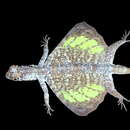en
names in breadcrumbs


The adults of this species are extremely agile and are very difficult to capture (Hairston, 1957).
The lizard appears to be a common species and is not listed as threatened at the current time.
Humans do not eat the flying lizard. In fact, this species is believed to be poisonous by many Philippine people, however, this is false (Taylor, 1966). Thus, the only benefit is the esthetic value of seeing such a colorful species of lizard take 'flight.'
The Flying Lizard is generally an insectivore, feeding mostly on small ants and termites. The lizard is described as a sit and wait feeder, meaning it will generally sit next to a tree trunk waiting for the ants to come to it. When the ant or termite is close enough, the lizard is able to pick it up without shifting its own body. The lizard then chews the insect (Mori and Hikida, 1994).
The Flying Lizard is found in tropical rain forests in southern India and Southeast Asia. This includes the Philippine Islands as well as Borneo (Taylor, 1966).
Biogeographic Regions: oriental (Native )
The flying lizard is found mainly in rain forests and tropical areas that can provide adequate number of trees for the lizard to jump from (Hairston, 1957).
Terrestrial Biomes: forest ; rainforest
The flying lizard is characterized by a large set of "wings" along the sides of the body, which are used for flight. These are supported by elongated ribs. They also have a gular flap called a dewlap, which is located under the head. This tissue is used during displays. The body is very depressed and elongate. The male flying lizard is approximately 195 mm in length while the female is 212 mm. This includes the length of the long slender tail which is approximately 114 mm on males and 132 mm on females (Taylor, 1966). The species is distinguished from other Dracos by the rows of rectangular brown spots on the top of the wing membranes, and black spots on the bottom of the wing (Mori and Hikida, 1994). The male Draco has a long pointed dewlap, which is bright yellow. They also have bluish color on the ventral side of the wings, and brown on the dorsal side. Females are slightly different in that the dewlap is smaller and bluish gray. Also, the ventral side of the wings is yellow (Mori and Hikida, 1994).
It is not known exactly when reproduction occurs, but it is assumed to be in December and January. Males, and occasionally females, show several displays. These include the spreading of the wings and a bobbing motion of the entire body when the two are in close proximity to each other. The male will also spread his dewlap to a fully erect position and then circle the female three times before copulation. The female will only show display patterns to stop or prevent copulation (Hairston, 1957). The female Draco will build a nest for the eggs by forcing her head into the soil to create a small hole. She will then lay five eggs into the hole and cover them with dirt, packing the soil on top of them with a patting motion of her head. For approximately twenty four hours, the female will guard the eggs fiercely. After this period, no further guarding occurs. Incubation of the eggs take approximately 32 days (Card, 1994).
Draco volans, also commonly known as the common flying dragon, is a species of lizard in the family Agamidae.[2][3] The species is endemic to Southeast Asia.[2] Like other members of genus Draco, this species has the ability to glide using winglike lateral extensions of skin called patagia.[4]
The species is exclusively arboreal.[5]
Draco volans grows to a length of up to 22 cm (8.7 in), including the tail. The body is tan in colour with dark flecks.[6]
The patagium of the male is tan to bright orange with dark banding. The female's patagium has irregular markings rather than banding.[6]
This species can be found in tropical rainforests in Southeast Asia.[3] It is commonly found in early second growth forests, in open secondary forest, and on forest edges.[5]
The "wings" of D. volans are supported by its ribs, which form the skeleton of the patagia. However, its elongated ribs are superadded to aid forming its "wings", and not to assist respiration.[7]
This species is considered a passive glider, or parachutist.[8] However, previous studies have also shown that it can be considered a gliding animal.[9] This means that it doesn't have to deal with the aerodynamic and metabolic imperatives required for active flight.[10]
Draco volans is diurnal, and is "commonly seen running along branches, displaying, and gliding".[5]
The colouration of the patagia and the dewlap play key roles in the courtship of D. volans, with the males stretching out and displaying their patagia and dewlaps to get the attention of the females.[4]
Draco volans feeds mainly on ants, and possibly other insects like termites.[6][3] A study was conducted in Eastern Mindanao, Philippines, which found that the species exclusively feeds on ants.[5] It hunts by waiting near a tree trunk until ants come out and crawl close to its visual field; it grabs its prey without moving itself.[3]
The female common flying dragon digs a hole in the soil to serve as a nest, and lays eggs in it.[4]
 Male
Male Draco volans, also commonly known as the common flying dragon, is a species of lizard in the family Agamidae. The species is endemic to Southeast Asia. Like other members of genus Draco, this species has the ability to glide using winglike lateral extensions of skin called patagia.
The species is exclusively arboreal.